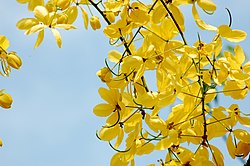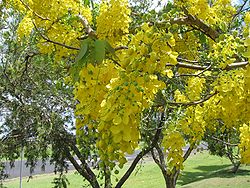The national flower for Thailand is Golden Shower Tree, locally called dok khuen (Thai: ดอกคูน) or Rachapruek (Thai: ราชพฤกษ์).
Cassia fistula, known as the golden shower tree and other names, is a flowering plant in the family Fabaceae, native to southern Asia, from southern Pakistan east through India to Myanmar and south to Sri Lanka. It is the national tree of Thailand, and its flower is Thailand's national flower. It is also state flower of Kerala in India and of immense importance amongst Malayali population. It is a popular ornamental plant and is an herbal medicine.
The golden shower tree is a medium-sized tree, growing to 10–20 m (33–66 ft) tall with fast growth. The leaves are deciduous, 15–60 cm (6–24 in) long, pinnate with 3–8 pairs of leaflets, each leaflet 7–21 cm (3–8 inches) long and 4–9 cm (1.5–3.5 in) broad. The flowers are produced in pendulous racemes 20–40 cm (8–15 in) long, each flower 4–7 cm diameter with five yellow petals of equal size and shape. The fruit is a legume, 30–60 cm (12–23 in) long and 1.5–2.5 cm (0.5–1 in) broad, with a pungent odor and containing several seeds. The seeds are poisonous. The tree has strong and very durable wood, and has been used to construct "Ahala Kanuwa", a place at Adams Peak, Sri Lanka, which is made of Cassia fistula ("ahala", "Ehela" or aehaela, in Sinhala) heartwood.
 Cassia fistula is widely grown as an ornamental plant in tropical and subtropical areas. It blooms in late spring. Flowering is profuse, with trees being covered with yellow flowers, many times with almost no leaf being seen. It will grow well in dry climates. Growth for this tree is best in full sun on well-drained soil; it is relatively drought tolerant and slightly salt tolerant. It will tolerate light brief frost, but can get damaged if frost persists. It can be subject to mildew or leaf spot, especially during the second half of the growing season. The tree will bloom better where there is pronounced difference between summer and winter temperatures.
Cassia fistula is widely grown as an ornamental plant in tropical and subtropical areas. It blooms in late spring. Flowering is profuse, with trees being covered with yellow flowers, many times with almost no leaf being seen. It will grow well in dry climates. Growth for this tree is best in full sun on well-drained soil; it is relatively drought tolerant and slightly salt tolerant. It will tolerate light brief frost, but can get damaged if frost persists. It can be subject to mildew or leaf spot, especially during the second half of the growing season. The tree will bloom better where there is pronounced difference between summer and winter temperatures.Medical use
 In Ayurvedic medicine, golden shower tree is known as aragvadha, meaning "disease killer". The root is considered a very strong purgative, and self-medication or any use without medical supervision is strongly advised against in Ayurvedic texts.
In Ayurvedic medicine, golden shower tree is known as aragvadha, meaning "disease killer". The root is considered a very strong purgative, and self-medication or any use without medical supervision is strongly advised against in Ayurvedic texts.Though its use in herbalism has been attested to for millennia, there has been rather little research in modern times. The purgative action is probably due to abundant 1,8-dihydroxyanthraquinone and derivatives thereof. Many Fabaceae are a source of potent entheogens and other psychoactive compounds, e.g. tryptamines; such plants are rarely found among the Caesalpinioideae. There is also a rare case of it being used for anal autoeroticism.
Culture
The golden shower tree is the national flower of Thailand; its yellow flowers symbolize Thai royalty. A 2006-2007 flower festival, the Royal Flora Ratchaphruek, was named after the tree, which is most often called dok khuen or ratchaphruek in Thailand. The golden shower tree is the state flower of Kerala in India. The flowers are of ritual importance in the Vishu festival of the Kerala state of India, and the tree was depicted on a 20 Indian rupees stamp. C. fistula is also featured on a 2003 joint Canadian-Thai design for a 48 cent stamp, part of a series featuring national emblems. Cassia acutifolia, the pudding-pipe tree, furnishes the cassia pods of commerce.
Source, Images: http://en.wikipedia.org/wiki/Golden_Shower_Tree













1 comments:
yes it is very true and you have provided very useful information. please read:- http://www.tripne.com/2018/08/national-flower-of-thailand.html
Post a Comment